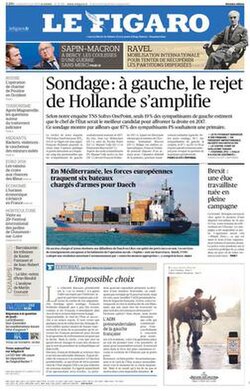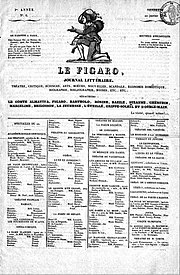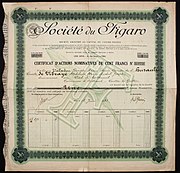 Front page of 22 November 2015 | |
| Type | Daily newspaper (since 16 November 1866) |
|---|---|
| Format | Berliner |
| Owner(s) | Groupe Figaro (Dassault Group) |
| Editor | Alexis Brézet[1] |
| Founded | 15 January 1826 |
| Political alignment | |
| Language | French |
| Headquarters | 14 Boulevard Haussmann 75009 Paris |
| Country | France |
| Circulation | 354,853 (total, 2022)[7] 84,000 (digital, 2018)[8] |
| ISSN | 0182-5852 (print) 1638-606X (web) |
| OCLC number | 473539292 |
| Website | www |
Le Figaro (French: [lə fiɡaʁo] ) is a French daily morning newspaper founded in 1826. It was named after Figaro, a character in a play by polymath Beaumarchais (1732–1799); one of his lines became the paper's motto: "Without the freedom to criticise, there is no flattering praise".
The oldest national newspaper in France, Le Figaro is one of three French newspapers of record, along with Le Monde and Libération.[9] Since 2004, the newspaper has been owned by Dassault Group. Its editorial director has been Alexis Brézet since 2012.[10] Le Figaro is the second-largest national newspaper in France, after Le Monde.[11] It has a centre-right editorial stance and is headquartered on Boulevard Haussmann in the 9th arrondissement of Paris.[9] Other Groupe Figaro publications include Le Figaro Magazine, TV Magazine and Evene. The paper is published in Berliner format.
History
[edit]

Le Figaro was founded as a satirical weekly in 1826,[12][13] taking its name and motto from Le Mariage de Figaro, the 1778 play by Pierre Beaumarchais that poked fun at privilege. Its motto, from Figaro's monologue in the play's final act, is "Sans la liberté de blâmer, il n'est point d'éloge flatteur" ("Without the freedom to criticise, there is no flattering praise"). In 1833, editor Nestor Roqueplan fought a duel with a Colonel Gallois, who was offended by an article in Le Figaro, and was wounded but recovered.[14] Albert Wolff, Émile Zola, Jean-Baptiste Alphonse Karr, Théophile Gautier, and Jules Arsène Arnaud Claretie were among the paper's early contributors. It was published somewhat irregularly until 1854, when it was taken over by Hippolyte de Villemessant.
In 1866, Le Figaro became a daily newspaper.[15] Its first daily edition, that of 16 November 1866, sold 56,000 copies, having highest circulation of any newspaper in France. Its editorial line was royalist.[16] Pauline Savari was among the contributors to the paper at this time.
On 20 February 1909 Le Figaro published a manifesto signed by Filippo Tommaso Marinetti which initiated the establishment of Futurism in art.[17]
On 16 March 1914, Gaston Calmette, the editor of Le Figaro, was assassinated by Henriette Caillaux, the wife of Finance Minister Joseph Caillaux, after he published a letter that cast serious doubt on her husband's integrity.[18] In 1922, Le Figaro was purchased by perfume millionaire François Coty.[19] Abel Faivre did cartoons for the paper.[20] Coty enraged many in March 1929 when he renamed the paper simply Figaro, which it remained until 1933.[21]
By the start of World War II, Le Figaro had become France's leading newspaper. After the war, it became the voice of the upper middle class, and continues to maintain a conservative position.

In 1975, Le Figaro was bought by Robert Hersant's Socpresse. In 1999, The Carlyle Group obtained a 40% stake in the paper, which it later sold in March 2002. Since March 2004, Le Figaro has been controlled by Serge Dassault,[12] a conservative businessman and politician best known for running the aircraft manufacturer Dassault Aviation, which he inherited from his father, its founder, Marcel Dassault (1892–1986). Dassault owns 80% of the paper, by way of its media subsidiary Groupe Figaro.[12]
Franz-Olivier Giesbert was editorial director of Le Figaro from 1998 to 2000.[22]
In 2006, Le Figaro was banned in Egypt and Tunisia for publishing articles allegedly insulting Islam.[23][24]
Le Figaro switched to Berliner format in 2009.[25] The paper has published The New York Times International Weekly on Friday since 2009, an 8-page supplement featuring a selection of articles from The New York Times translated into French. In 2010, Lefigaro.fr created a section called Le Figaro in English,[26] which provides the global English-speaking community with daily original or translated content from Le Figaro's website. The section ended in 2012.[27]
In the 2010s, Le Figaro saw future presidential candidate Éric Zemmour's columns garner great interest among readers that would later serve to launch his political career.[28]
Logo
[edit]-
Logo during the 1820s
-
Logo from an 1854 issue
-
Logo since the 1920s
-
Logo of Le Figaro from a 1952 issue
Editorial stance and controversies
[edit]| This article is part of a series on |
| Conservatism in France |
|---|
 |
Le Figaro has traditionally held a conservative editorial stance, becoming the voice of the French upper and middle classes.[10] More recently, the newspaper's political stance has become more centrist.
The newspaper's ownership by Serge Dassault was a source of controversy in terms of conflict-of-interest, as Dassault also owned a major military supplier and served in political positions from the Union for a Popular Movement party. His son Olivier Dassault served as a member of the French National Assembly.[29] Dassault has remarked in an interview in 2004 on the public radio station France Inter that "newspapers must promulgate healthy ideas" and that "left-wing ideas are not healthy ideas."[30]
In February 2012, a general assembly of the newspaper's journalists adopted a motion accusing the paper's managing editor, Étienne Mougeotte, of having made Le Figaro into the "bulletin" of the governing party, the Union for a Popular Movement, of the government and of President Nicolas Sarkozy. They requested more pluralism and "honesty" and accused the paper of one-sided political reporting. Mougeotte had previously said that Le Figaro would do nothing to embarrass the government and the right.[31][32][33] Mougeotte publicly replied: "Our editorial line pleases our readers as it is, it works. I don't see why I should change it. [...] We are a right-wing newspaper and we express it clearly, by the way. Our readers know it, our journalists too. There's nothing new to that!"[34]
Circulation history
[edit]In the period of 1995–96, the paper had a circulation of 391,533 copies, behind Le Parisien's 451,159 copies.[35]
| Year | 1999 | 2000 | 2001 | 2002 | 2003 | 2004 | 2005 | 2006 | 2007 | 2008 | 2009 | 2010 |
|---|---|---|---|---|---|---|---|---|---|---|---|---|
| Circulation | 366,690 | 360,909 | 366,529 | 369,108 | 369,706 | 365,083 | 337,118 | 332,818 | 338,618 | 330,482 | 323,991 | 325,509 |
| Year | 2011 | 2012 | 2013 | 2014 | 2015 | 2016 | 2017 | 2018 | 2019 | 2020 |
|---|---|---|---|---|---|---|---|---|---|---|
| Circulation | 329,367 | 330,952 | 324,170 | 320,732 | 317,152 | 311,127 | 312,994 | 313,694 | 329,462 | 331,927 |
See also
[edit]References
[edit]- ^ "Brexit: Europe's media eye more referendums". BBC News. 27 June 2016. Retrieved 9 June 2020.
- ^ Martin, Thomas; Binet, Laurent (2018). "Left Versus Right, or Mainstream Versus Margins? Divisions in French Media and Reactions to the 'Brexit' Vote". In Anthony Ridge-Newman; Fernando León-Solís; Hugh O'Donnell (eds.). Reporting the Road to Brexit: International Media and the EU Referendum 2016. Springer. p. 146. ISBN 978-3-319-73681-5.
- ^ Anna Galluzzi, ed. (2014). Libraries and Public Perception: A Comparative Analysis of the European Press. Elsevier. p. 29. ISBN 9781780634258.
- ^ Eric Kaufmann, ed. (2019). Whiteshift: Populism, Immigration, and the Future of White Majorities. Abrams. ISBN 9781468316988.
Two newer stars on the French right are Renaud Camus, author of Le Grand Remplacement (The Great Replacement) and Éric Zemmour, an observant Jew of Algerian provenance who wrote for the centre-right Le Figaro.
- ^ Semi Purhonen; Riie Heikkilä; Irmak Karademir Hazir, eds. (2018). Enter Culture, Exit Arts?: The Transformation of Cultural Hierarchies in European Newspaper Culture Sections, 1960–2010. Routledge. p. 15. ISBN 9781351728041.
- ^ a b Raymond Kuh, The Media in France. Routledge, London and New York, 1995. Retrieved 4 September 2016.
- ^ "Le Figaro − History". Alliance pour les chiffres de la presse et des médias (in French). n.d. Archived from the original on 24 June 2023. Retrieved 24 June 2023.
- ^ Le Figaro internationalmediasales.net
- ^ a b "Le Figaro – French newspaper".
- ^ a b "The press in France". 11 November 2006 – via news.bbc.co.uk.
- ^ "Quel bilan pour la presse en 2020?" [What balance sheet for the press in 2020?]. Europe 1 (in French). Agence France-Presse. 11 February 2021. Archived from the original on 5 December 2021. Retrieved 24 June 2023.
- ^ a b c "The press in France". BBC. 11 November 2006. Retrieved 22 November 2014.
- ^ "Media Landscape Media Claims" (PDF). European Social Survey. May 2014. Archived from the original (PDF) on 16 August 2014. Retrieved 12 January 2015.
- ^ Millingen, J.G. (2004). The History of Dueling Including Narratives of the Most Remarkable Encounters.
- ^ "Historical development of the media in France" (PDF). McGraw-Hill Education. Archived from the original (PDF) on 25 February 2015. Retrieved 24 February 2015.
- ^ Alan Grubb, The Politics of Pessimism: Albert de Broglie and Conservative Politics in the Early Third Republic
- ^ Simonetta Falasca-Zamponi (1992). The aestheticization of politics: A study of power in Mussolini's fascist Italy (PhD thesis). University of California, Berkeley. p. 67. ISBN 979-8-207-42060-8. ProQuest 303984014.
- ^ Sarah Sissmann and Christophe Barbier, "Une épouse outragée" Archived 3 July 2006 at the Wayback Machine, L'Express, 30 August 2004. Retrieved 27 January 2007.
- ^ Janet Flanner (3 May 1930),"Perfume and Politics", The New Yorker. Republished 7 May 2005. Retrieved 27 January 2007.
- ^ "Deposit Your Gold for France. Gold Fights for Victory". World Digital Library. 1915. Retrieved 26 October 2013.
- ^ Roulhac Toledano, Elizabeth Z. Coty, "Napoleon of the Press","François Coty: Fragrance, Power, Money". Retrieved 28 May 2018
- ^ "Franz-Olivier Giesbert". Le Soir (in French). 26 October 2022. Archived from the original on 23 June 2023. Retrieved 23 June 2023.
- ^ "The impact of blasphemy laws on human Rights" (Policy Brief). Freedom House. Retrieved 29 September 2013.
- ^ "Tunisia, Egypt ban newspaper editions on controversy over pope's comments". CPJ. New York. 27 September 2006. Retrieved 29 September 2013.
- ^ "Le Figaro". Euro Topics. Archived from the original on 13 April 2015. Retrieved 25 February 2015.
- ^ "Mon Figaro - Cercle - Le Figaro in English - articles". Le Figaro. Archived from the original on 5 July 2012. Retrieved 5 July 2012.
- ^ "Mon Figaro - This Week's Top Stories from France". Le Figaro. 26 April 2012. Retrieved 5 July 2012.
- ^ "Présidentielle 2022 : Zemmour se retire du Figaro pour la promotion de son livre, un pas de plus vers une candidature ?", Le Parisien (in French), 1 September 2021.
- ^ "Dassault se sépare d'Yves de Chaisemartin", Le Figaro, 1 October 2004. Retrieved 27 January 2007.
- ^ "M. Dassault veut une presse aux « idées saines »", Le Monde, 12 December 2004. Retrieved 27 January 2007.
- ^ ""Le Figaro" n'est pas "le bulletin d'un parti"", Le Monde, 9 February 2012
- ^ "La question du jour. "Le Figaro" est-il un journal d'opinion ou un "bulletin" de l'UMP?", Le Nouvel Observateur, 10 February 2012
- ^ "Présidentielle : les journalistes du Figaro réclament un journal plus « honnête »", Rue89, 9 February 2012
- ^ ""Le Figaro" : Mougeotte répond aux critiques de ses journalistes", Le Nouvel Observateur, 10 February 2012
- ^ Media Policy: Convergence, Concentration & Commerce. SAGE Publications. 24 September 1998. p. 10. ISBN 978-1-4462-6524-6. Retrieved 3 February 2014.
Further reading
[edit]- Merrill, John C. and Harold A. Fisher. The World's Great Dailies: Profiles of Fifty Newspapers (1980) pp 124–29
External links
[edit]- Le Figaro website (in French)
- Le Figaro digital archives from 1826 to 1952 in Gallica, the digital library of the BnF
| Daily |
| ||||||
|---|---|---|---|---|---|---|---|
| Weekly |
| ||||||
| Monthly |
| ||||||


